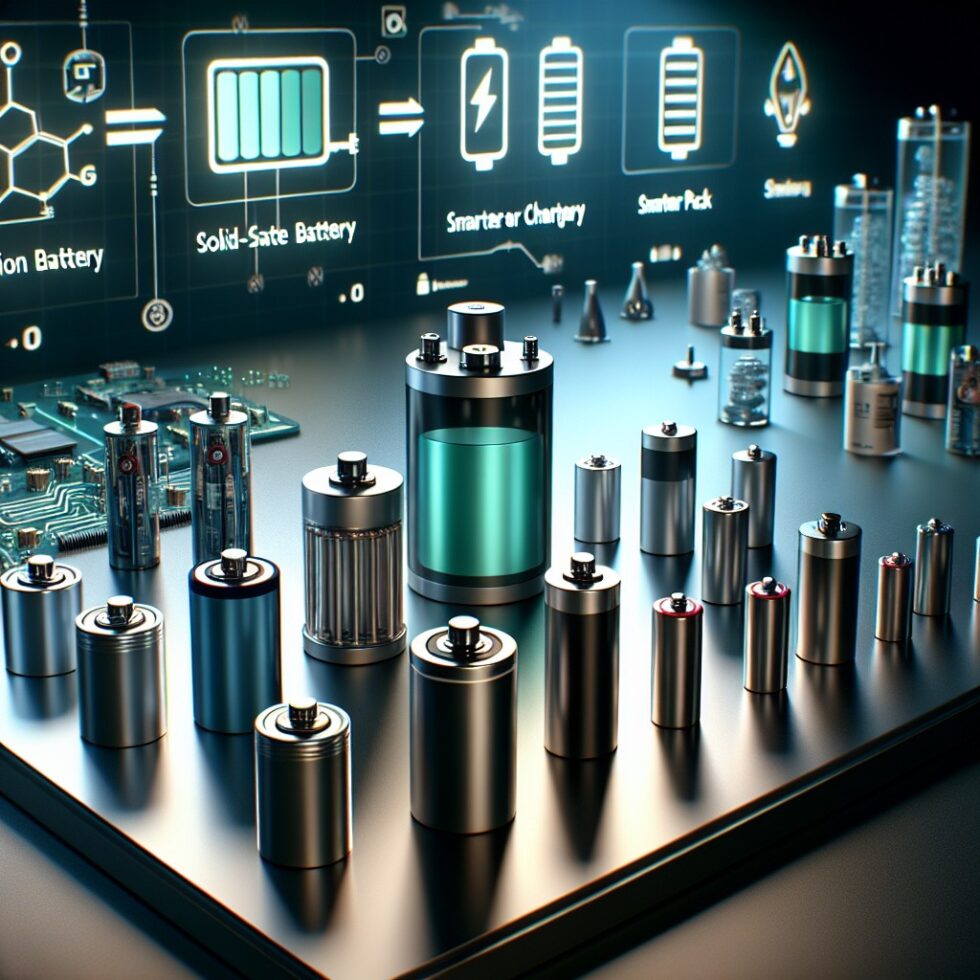
Battery technology is moving fast, but it rarely moves in a straight line. Headlines swing from miracle breakthroughs to scary recalls. In the middle of that noise, a quieter story is unfolding: practical advances that are reaching real products, supply chains, and charging networks. This article focuses on what you’ll actually encounter in the next few years—across phones, laptops, e‑bikes, electric vehicles, and stationary storage—and how to make smarter decisions as a user or a builder.
Why batteries are changing now
Three forces are reshaping the field at once. First, demand is surging: more devices, more EVs, and more grid storage to back up wind and solar. Second, materials pressure is real: geopolitics, mining impacts, and nickel/cobalt price swings push manufacturers to diversify chemistries. Third, better electronics and models make it possible to squeeze more performance out of existing cells without abusing them.
That’s why you’re seeing sodium‑ion prototypes ship, lithium‑iron phosphate (LFP) move into mainstream cars, and solid‑state work creep from labs toward limited runs. At the pack level, design shifts like cell‑to‑pack and improved thermal management are becoming standard. Charging is getting smarter, too—both in how plugs talk to cars and how devices decide what “100%” should mean today.
The new chemistries you’ll actually see
Sodium‑ion: lower cost, good at cold, modest energy
Sodium‑ion cells swap lithium for abundant sodium. The result is a chemistry with lower raw material cost and strong low‑temperature performance, but lower energy density than typical lithium‑ion. Expect today’s sodium‑ion to sit around 100–160 Wh/kg at the cell level, with ongoing work aimed higher. That’s not competitive for long‑range premium cars, but it’s useful for:
- Entry‑level EVs targeting short urban trips
- Micro‑mobility like e‑bikes and scooters that value cost over range
- Stationary storage where volume and weight matter less than price and safety
Some manufacturers are also exploring hybrid packs that blend sodium‑ion and LFP modules, letting power‑hungry loads use LFP while daily cycling leans into sodium for cost. If you buy budget EVs or storage cabinets in the next few years, you may encounter sodium‑ion without even noticing—apart from a lower price tag.
LFP and LMFP: safer and better than you might think
For a long time, LFP (lithium‑iron phosphate) was seen as the “cheap, low‑range” option. Advances in manufacturing, pack design, and LMFP (manganese‑doped LFP) are changing that. LFP is thermally stable and tolerant of repeated fast charging. LMFP bumps voltage a bit, inching energy density up while keeping safety benefits. Many mainstream EVs and energy storage systems already use LFP because:
- Cycle life is excellent, often exceeding 2,000–5,000 cycles in real conditions
- Thermal runaway risk is lower than high‑nickel chemistries
- Supply chain risk is reduced due to less reliance on nickel and cobalt
In consumer electronics, LFP remains less common because of size constraints, but it’s starting to appear in laptops and power stations where long life and safety matter more than thinness.
Silicon‑rich anodes: more range, careful engineering
Silicon can store far more lithium than graphite, but it swells a lot during cycling. The practical path today is graphite‑silicon composites. Used carefully, they deliver modest range boosts and fast‑charge support, especially in high‑nickel NMC cells. Look for incremental gains rather than magic leaps: a few to tens of percent more capacity, offset by careful charge profiles and thermal control to preserve cycle life.
Solid‑state: real progress, limited debut
“Solid‑state” covers several families of solid electrolytes—sulfide, oxide, and polymer—each with trade‑offs in conductivity, interface stability, and manufacturability. The promise is clear: higher energy density, better safety, and possibly faster charging. The near‑term reality, though, is cautious:
- Sulfides boast high conductivity but are sensitive to moisture and interfaces
- Oxides are stable but harder to process at scale and can be brittle
- Polymers are manufacturable but often need higher temperatures to conduct well
Expect early deployments in premium devices and select EV trims where manufacturers can control pack conditions tightly and justify cost. Semisolid or “hybrid” approaches—thickened liquid electrolytes with solid components—will likely bridge the gap before true all‑solid systems become mass‑market. In short: genuine progress, but don’t bank your 2025 purchase on it unless a vendor commits to specs you can verify.
Pack engineering is quietly getting safer and smarter
Cell‑to‑pack and structural designs
Traditional packs group cells into modules, then modules into packs. New designs skip modules entirely (cell‑to‑pack) or integrate the pack into the vehicle structure. Fewer parts mean better volumetric efficiency and lower cost per kWh. The trade‑offs are serviceability and thermal propagation containment: fewer “firebreaks” between large blocks of cells. That’s why modern cell‑to‑pack systems pair this design with robust sensors and propagation barriers that act fast if a cell vents.
Thermal paths that actually work
Heat is the silent battery killer. Modern packs use improved cooling plates, tab cooling (pulling heat from the cell’s ends where current concentrates), and carefully routed refrigerant loops. Some stationary systems use immersion cooling in dielectric fluids, trading complexity for excellent, uniform heat removal. You’ll also see smarter preconditioning—warming cells before fast charging in winter and cooling them after a hard drive—to reduce stress and speed charging.
Better BMS: from estimates to predictions
State‑of‑charge (SoC) and state‑of‑health (SoH) used to be educated guesses. New battery management systems pair model‑based observers with data‑driven corrections. Techniques like differential capacity analysis, impedance tracking, and adaptive open‑circuit voltage models make SoC more accurate and predict drift earlier. That unlocks:
- Gentler charging when cells are cold or aging
- Cell balancing that’s proactive rather than reactive
- Early‑warning maintenance for packs in fleets and storage sites
For builders, this means tighter specs and more degrees of freedom. For users, it means fewer sudden range drops and better safety without thinking about it.
Standards that matter in the background
Shipping rules (UN 38.3), safety certifications (UL, IEC), and transport packaging standards are updating to reflect larger packs and new chemistries. You don’t need to memorize acronyms, but it’s worth checking what a product claims and who verified it. Genuine third‑party testing beats marketing labels—and determines what happens if something fails.
Charging that treats batteries kindly
Fast, but not foolish: the charging handshake
Charging is moving from brute force to negotiation. In EVs, ISO 15118 enables Plug & Charge and richer messages between car and charger. Network protocols like OCPP 2.0.1 let fleets and utilities coordinate when and how to deliver power. The result is fast charging that adapts to the battery’s condition and the grid’s constraints, rather than hitting maximum amps at all costs.
On phones and laptops, the same idea appears as “smart charging.” Devices learn your schedule and hold at 70–80% until just before you need 100%. Or they cap daily charge at 80–90% by default. These features are simple but effective: high voltage at full charge accelerates side reactions that age cells. Avoiding long dwell time at 100% can extend life significantly.
Profiles and preconditioning
CC‑CV (constant current, then constant voltage) remains the backbone of lithium charging, but it’s getting company. Pulsed profiles, temperature‑aware current limiting, and adaptive cutoffs based on internal resistance are showing up in packs that want to maximize throughput without sacrificing cycles. In EVs, thermal preconditioning before supercharging in cold weather can halve charge times and reduce lithium plating risk.
Your daily habits still matter
You can’t outsmart chemistry, but you can give it a good life:
- Avoid leaving devices at 100% and hot for hours; heat plus high voltage ages cells
- Use moderate fast charging when possible; save the absolute fastest rates for trips
- In storage, leave packs around 40–60% in a cool, dry place
- Run a full cycle occasionally in laptops to recalibrate the gauge (for the meter, not the cell chemistry)
Second life and end‑of‑life: making packs work twice
Second‑life storage is getting organized
When EV packs no longer meet range targets (often around 70–80% of original capacity), they can still serve as stationary storage. The trick is grading: testing modules to match similar cells together so a second‑life rack behaves predictably. Better diagnostics from the first life—rich cycling histories, temperatures, and voltage curves—make this grading more accurate, which means fewer surprises later.
Second‑life deployments shine in applications like solar evening peak shaving, microgrids, and backup power for commercial buildings. Economics depend on local electricity prices and the cost to disassemble, test, and repackage modules. As more standardized pack designs emerge, second‑life projects should go from bespoke to repeatable.
Recycling moves beyond “burn and leach”
Historically, recycling used pyrometallurgy (smelting), which wastes some materials and burns energy. Newer hydrometallurgical and direct recycling processes recover more value, including active materials like cathode powders, with less energy. This matters not only for environmental reasons but also for supply security. Recovering lithium, nickel, and cobalt domestically reduces exposure to global shocks.
Expect clearer labeling and better tracking—often via digital records tied to a pack’s serial number—so recyclers know what they’re handling. That visibility helps compliance, safety in transit, and ultimately, yield in recovery.
How to match the chemistry to the job
There’s no single “best battery.” There’s the right battery for a job. Use this short checklist when you evaluate options for a product or purchase:
- Energy density: Do you need every gram and cubic centimeter? Phones and drones do. Stationary cabinets don’t.
- Power and charge rate: Does the job spike power or demand fast fills? Look for low internal resistance and robust thermal paths.
- Cycle life: Daily cycling favors LFP and LMFP. Occasional deep cycles can suit NMC variants with silicon blends.
- Temperature range: Cold climates reward sodium‑ion and well‑managed LFP. Extreme heat punishes everything without good cooling.
- Safety: Consider cell format, separators, flame retardants, and pack layout—not just chemistry.
- Supply chain: If sourcing risk is a concern, prefer chemistries with abundant materials and multiple suppliers.
- Serviceability: Can modules be replaced? Are parts standardized? For fleets and storage, downtime costs matter.
- End‑of‑life: Is recycling available locally? Are materials recoverable with today’s methods?
Myths that waste time (and batteries)
“Solid‑state makes everything safer immediately.”
Solid electrolytes can reduce flammability, but safety is a system property. Interfaces can still fail. Packs still need sensors, fuses, and thermal management. The first wave of solid‑state will be conservative in performance to prioritize reliability.
“Fast charging ruins batteries.”
Abuse ruins batteries. Managed fast charging within temperature and voltage limits is fine. The risk comes from charging cold cells aggressively or pushing past safe taper points. Modern BMS logic and charging networks are designed to avoid those errors.
“You must fully discharge to prevent memory effect.”
Memory effect is a nickel‑cadmium issue. Lithium‑ion does not benefit from deep discharges. In fact, living at low state‑of‑charge can stress cells if they reach truly empty. Moderate cycling with occasional full runs for gauge calibration is best.
“All chemistries age the same way.”
They don’t. Aging pathways vary: electrolyte oxidation near full charge, lithium plating in the cold, cathode cracking under high C‑rates. That’s why one brand thrives at 90% daily charge and another prefers 80%. Trust the device maker’s guidance when it’s clear and evidence‑based.
What this means for people and businesses
If you’re buying devices
Expect more phones and laptops with adaptive charging and built‑in limits you can toggle. Power stations and e‑bikes will tout LFP for longevity and safety. High‑end devices may advertise silicon‑enhanced cells for burst performance, with smart software to slow aging.
If you’re choosing an EV
Don’t fixate on chemistry alone. Look at the whole system: warranty, thermal management, charging software, and pack design. LFP models may deliver less ultimate range but reward you with stable performance and long life. Premium trims may offer higher nickel chemistries or early solid‑state as an option; verify how those packs are warrantied and cooled.
If you’re building products
Design for thermal uniformity, not just total heat removal. Give your BMS enough sensors and compute headroom to run robust SoC/SoH estimators. Choose connectors and interconnects that are serviceable under field conditions. Plan for end‑of‑life on day one: labeling, data logs for grading, and a recycling partner who understands your format.
If you manage fleets or storage
Use data to move from calendar‑based to condition‑based maintenance. Track cell balance drift, internal resistance trends, and temperature gradients across racks. Coordinate charge windows with tariffs and performance needs. Small changes—like reducing average SoC when idle—can add years to pack life and lower total cost.
Design patterns to borrow now
The industry is converging on a handful of patterns that work across chemistries:
- Keep cells cool and even: target small temperature deltas across the pack under worst‑case load
- Limit high‑voltage dwell: avoid camping at 100%; schedule top‑off near departure
- Balance often, gently: passive balancing during light load, active balancing if pack size justifies it
- Predict, don’t react: use trend analysis to catch degradation early rather than chasing faults
- Document everything: pack build, test history, and cycling logs improve second‑life value and safety
What to watch next (without the hype)
Keep an eye on three fronts:
- Sodium‑ion maturation: If energy density inches up and pack integration improves, it will win big in storage and low‑cost EVs.
- Solid‑state pilots: Follow early deployments for cycle life, cold performance, and manufacturability—not just lab numbers.
- Charging networks + software: Plug‑and‑play roaming, grid‑aware charge scheduling, and better preconditioning are near‑term wins.
The common thread is systems thinking. Chemistry matters, but the pack, software, and charging context make or break real‑world performance. The best products in the next few years won’t chase a single spec. They’ll pair a sensible chemistry with excellent engineering and let the whole system carry the weight.
Summary:
- Sodium‑ion is arriving in low‑cost EVs, micro‑mobility, and stationary storage; energy density is modest, cost and cold performance are strong.
- LFP/LMFP remains a practical choice for long life and safety across EVs and storage, with improving energy density.
- Silicon‑rich anodes add capacity and fast‑charge support when managed carefully; expect incremental, not dramatic, gains.
- Solid‑state is progressing, with limited early deployments; benefits are real but scaling and interfaces remain hard.
- Pack design advances—cell‑to‑pack, better cooling, smarter BMS—are delivering safer, denser, more durable systems.
- Charging is shifting to negotiation: ISO 15118 and OCPP 2.0.1 enable faster, kinder charging and grid coordination.
- Second life is becoming systematic; better grading and logs improve economics, while modern recycling recovers more value.
- Match chemistry to the job: consider density, cycle life, temperature, safety, supply chain, serviceability, and end‑of‑life.
- Good habits still help: avoid hot 100% dwells, fast charge within reason, and store packs around mid‑SoC when idle.





